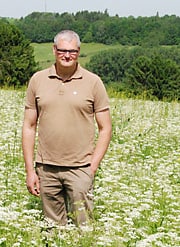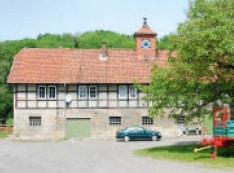Caraway
 Our caraway thrives in the tranquil Lippische Bergland in North Rhine-Westphalia. Soil and climate are ideal for him, his seeds develop a high oil content and are particularly aromatic.
Our caraway thrives in the tranquil Lippische Bergland in North Rhine-Westphalia. Soil and climate are ideal for him, his seeds develop a high oil content and are particularly aromatic.
Caraway seeds from North Rhine-Westphalia
The old half-timbered farmhouse stands on a hill just outside a village with the pretty name Kükenbruch. From up here our view wanders over the gently rolling landscape, in the distance a chain of hills. Just under 220 metres in altitude.
We are in the Lippischen Bergland, a low mountain range foothills of the Weser Bergland in East Westphalia-Lippe. It is an ice age moraine area, the soils here are loamy and shallow. “Underneath comes the bare rock,” says Matthias Bünte. The organic farmer cultivates 20 hectares here, growing caraway for Herbaria. “Everything used to be grassland here,” he remembers.
The grandparents had seven dairy cows and the father had potato propagation. However, Bünte junior first trained as a distiller and then as a farmer. Then he returned to the farm and switched to organic farming. “For 14 years we were a Demeter farm,” says the farmer. He has been with Bioland since 2009. There are a few cows, sheep and chickens and a hectare of fruit trees. Above all, however, Bünte produces mustard, various cereals such as spelt and naked oats, edible peas and our caraway seeds.
 Harvesting takes place in the second year
Harvesting takes place in the second year
Caraway is sown in spring – mostly with annual underseeds such as fenugreek and linseed. The lower seeds are threshed and sorted in summer. The caraway, however, grows slowly and hibernates in the rosette stage. “In the second spring we fertilise with dung compost”, says our producer, “then the caraway is driven upwards”. When it flowers in May, it hums and hums in the fields.
At Büntes Hof there are some bee colonies of a friendly beekeeper – the bees like the delicate, white flowers very much. The honey harvested during this time has a light caraway aroma. “Quite something fine,” enthuses the 43-year-old. Harvesting takes place around mid-July. A classic combine harvester threshes out the grains, after which the wagons are dried. “In autumn I let the sheep of a travelling shepherd cross the field”, explains Bünte, “the sheep keep the caraway short for me”. In the third year the caraway sprouts again and can be harvested again in summer.
Maintaining the plaice
Caraway is frugal, it hardly needs nutrients. This is why it is often cultivated after cereals, which consume many nutrients from the soil. “After the last caraway harvest we usually sow peas or other legumes as green manure”, Bünte explains, “then the soil can replenish its nutrient reserves and build up humus”. The man has an intimate relationship with his soil. He speaks of soil fermentation, an almost forgotten term today. “The right soil fermentation is achieved when the soil becomes active again after the winter, i.e. when the soil organisms multiply again.”
Thus the soil is ventilated again after the winter rainfall. Therefore, one should not prepare the seedbed in the field too early in spring so that the still wet soil is not unnecessarily compacted. The sensitive organic farmer relies on his feeling “when the soil is ready”. After all, you have to “take care of your plaice”. Caraway is an ideal fruit for Büntes’ shallow but heavy soil. As the rock comes out of the ground after only 35 centimetres, the plant does not have a lot of nutrients at its disposal, so it does not grow excessively high – but forms many grains. The heavy soil can store water well, which is why the seeds ripen very slowly – and develop a lot of essential oil. And that is exactly what Matthias Bünte is aiming for. Good caraway has an oil content of around 4 – 5 percent. Büntes Bünte caraway is sometimes a bit higher. “You just have to know how to use the given site conditions.”
 The seeds are processed in the nearby partner plant. With sieves, air classifiers and colour sorters, the harvest is guaranteed to be of pure quality. For an optimal result you should know your machines well”, explains our Kümmele expert”, “you should know which screw to turn, e.g. to sort out the too small grains”. After all, employees pack caraway into 25 kg bags with the almost historical but still calibrated scales. And then the precious goods make their way to Bavaria…
The seeds are processed in the nearby partner plant. With sieves, air classifiers and colour sorters, the harvest is guaranteed to be of pure quality. For an optimal result you should know your machines well”, explains our Kümmele expert”, “you should know which screw to turn, e.g. to sort out the too small grains”. After all, employees pack caraway into 25 kg bags with the almost historical but still calibrated scales. And then the precious goods make their way to Bavaria…

